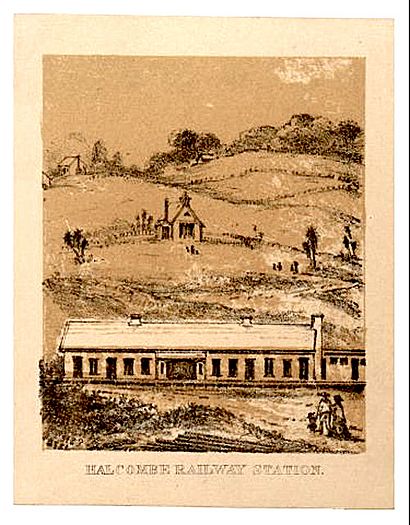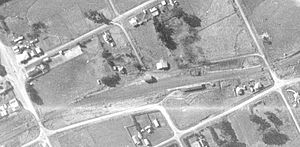Halcombe railway station facts for kids
Quick facts for kids
Halcombe railway station
|
|||||||||||
|---|---|---|---|---|---|---|---|---|---|---|---|

Halcombe railway station about 1878
- drawn by Edith Halcombe |
|||||||||||
| Location | New Zealand | ||||||||||
| Coordinates | 40°08′46″S 175°29′41″E / 40.146058°S 175.49484°E | ||||||||||
| Elevation | 118 m (387 ft) | ||||||||||
| Line(s) | North Island Main Trunk | ||||||||||
| Distance | Wellington 165.73 km (102.98 mi) | ||||||||||
| History | |||||||||||
| Opened | 22 April 1878 | ||||||||||
| Closed | 27 March 1983 | ||||||||||
| Electrified | June 1988 | ||||||||||
| Services | |||||||||||
|
|||||||||||
Halcombe railway station was a train station in New Zealand. It was located on the North Island Main Trunk (NIMT) railway line. This station served the small village of Halcombe in the Manawatū-Whanganui region.
The station opened in 1878 and operated for many years. It finally closed its doors in 1983. Halcombe was once an important stop on the railway that connected Whanganui and Foxton. Today, only a single railway track runs through the old station site. The extra tracks that allowed trains to pass each other were removed in 1983.
Contents
History of Halcombe Station
The first trains arrived at Halcombe station on April 22, 1878. This was when the railway section from Feilding to Halcombe was completed. A month later, on May 20, 1878, the railway line was finished all the way to Marton. This new line connected the important ports of Foxton and Whanganui. The mayor of Palmerston North even declared a public holiday to celebrate!
The first station building was quite small. It was a "5th class station" and was finished in April 1877.
A Bigger Station
Later, it was decided that Halcombe would be the main stop for passengers to get food and drinks. So, the original small station was moved to Greatford. A much larger station was then built at Halcombe. This new building was about 31 meters long and 6 meters wide. It was completed by August 1879.
To make space for the growing station, the goods shed and loading area were moved in 1881. By 1896, the station was very well-equipped. It had special refreshment rooms, a kitchen, and a long passenger platform. There was also a large shed for goods, a loading area, and yards for cattle and sheep. A crane and a water supply for the trains were added a few years later.
In 1912, a covered porch (veranda) was added to the station building. This was still there in 1941. Houses for railway workers were also built nearby in 1916 and 1955.
In 1902, an excursion train had a small accident at the station. It went off the tracks near the points, which are parts of the track that guide trains.
Refreshment Rooms: A Place to Eat
From the beginning, Halcombe was chosen as the place where trains would stop for passengers to buy food and drinks. These were called "refreshment rooms." Some people thought Marton or Sanson would have been better choices.
Trains would stop for about 40 minutes at first, giving passengers time to eat. This stop time was later cut in half. The refreshment rooms were rented out to different businesses. For example, in 1878, the Halcombe Hotel ran them. However, from December 24, 1898, the refreshment rooms were moved to Marton.
Train Services and Passenger Numbers
When the North Island Main Trunk railway fully opened in 1909, Halcombe became a stop for express trains. These trains traveled between Wellington and New Plymouth. Even in the 1940s, Halcombe was still a regular stop for these important services.
The station kept records of how many passengers it served each year. The graph below shows how passenger numbers changed over time.
As you can see in the graph, the number of passengers grew at first. It also increased during the World Wars. However, after 1950, fewer people used the station. This was likely due to more people using cars and buses.
Engine Shed
A large building called an engine shed was built at Halcombe. This shed was used to store and maintain the steam engines (locomotives). Another shed was added in 1878-79. In 1894, it seems another shed was built for the engines.
Station Closure
Halcombe stopped being a fully staffed station on December 6, 1958. This meant there was no longer a station master or clerk working there all the time.
Sadly, on March 31, 1962, the main station building burned down. A small storage room was used as a temporary station for a while. The goods shed and yards for animals were approved for removal in 1973. By 1974, most of the station buildings were gone.
On March 27, 1983, Halcombe station officially closed to all train traffic. However, a small side track (siding) remained for a while.
Images for kids





